Msi Geforce Gtx 1080 Ti Lightning Z Review
Our Verdict
Although nosotros're not altogether satisfied with MSI's pricing and availability, an otherwise pristine product is absolutely convincing. In the German version of our review, which went live dorsum in August, the Lightning Z card earned a rare Editor's Pick award. It'due south that skillful. Simply we can no longer confer that laurels with so many other 1080 Tis out at that place readily available under $800.
For
- Loftier factory GPU Heave frequency
- Very skilful thermal solution
- Quiet fans
- Inappreciably any coil whine
- Lots of RGB effects to choose from
- External sensors
Confronting
- Ability consumption
- Near non-existent availability
- Inaccessible pricing
- Very heavy
- High starting fan pulse
- High ability consumption
Tom'southward Hardware Verdict
Although we're not altogether satisfied with MSI's pricing and availability, an otherwise pristine production is absolutely convincing. In the German version of our review, which went live back in August, the Lightning Z menu earned a rare Editor's Choice award. It's that adept. But nosotros can no longer confer that accolade with and then many other 1080 Tis out there readily available under $800.
Pros
- +
Loftier factory GPU Boost frequency
- +
Very skilful thermal solution
- +
Tranquillity fans
- +
Hardly any coil whine
- +
Lots of RGB furnishings to choose from
- +
External sensors
Cons
- -
Power consumption
- -
Well-nigh not-existent availability
- -
Inaccessible pricing
- -
Very heavy
- -
High starting fan pulse
- -
Loftier power consumption
Features & Specifications
MSI's GeForce GTX 1080 Ti Lightning Z is a express-edition flagship designed to show what the company'due south engineers can do. The upshot is an near 1.vii-kilogram behemoth that needs iii expansion slots worth of infinite to deliver high-stop air cooling.
The stock specifications that MSI cites may likewise be a footnote. Anyone buying such an overbuilt thermal solution surely plans to overclock anyhow. So, even though a base 1607 MHz and GPU Boost frequency of 1721 MHz in Lightning Style already sounds aggressive, we're anticipating more than.
Indeed, a high factory-set power target of 300W, in combination with binned GPUs (according to MSI) and top-end cooling guarantees loftier clock rates nether load in real gaming workloads. In addition, MSI overclocks its GDDR5X memory a bit, which should help at high resolutions with anti-aliasing enabled.
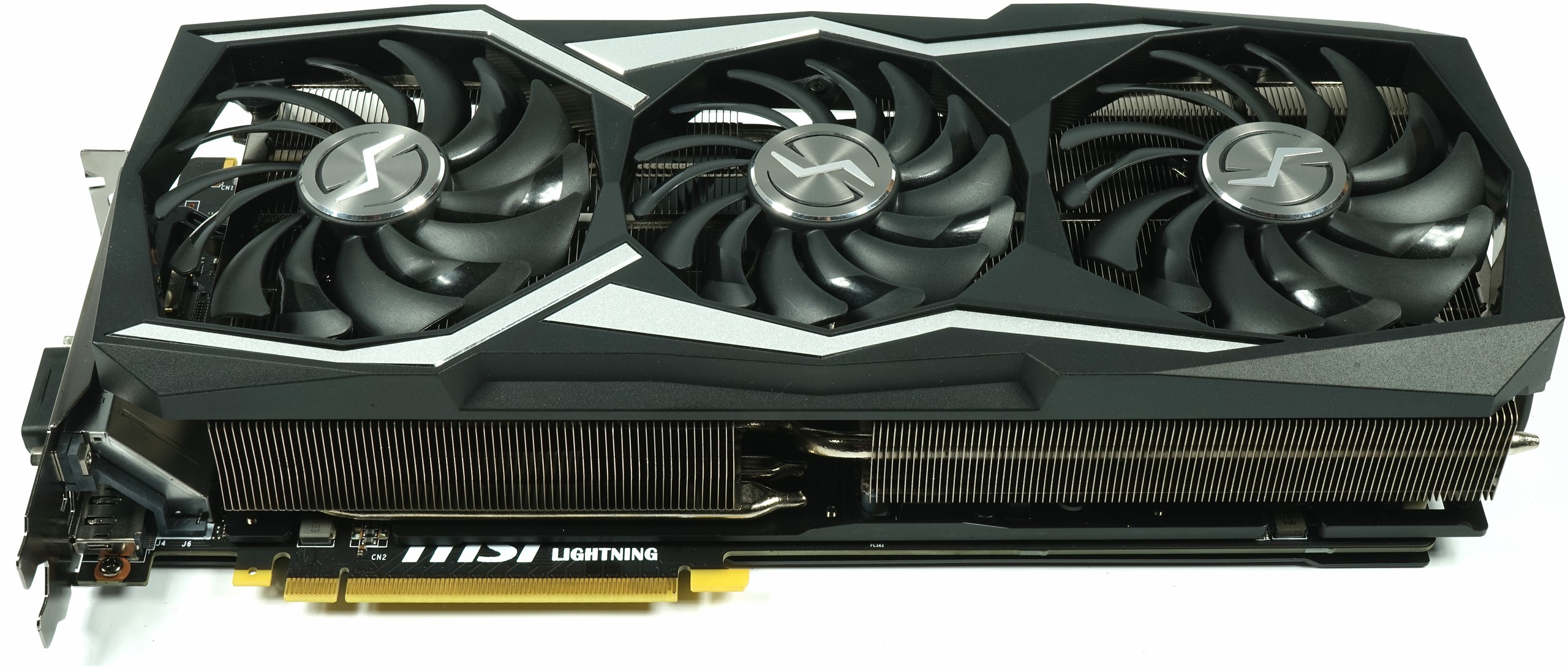
Since the actual performance of whatever third-party menu depends on the GPU Boost frequency it can sustain, and thus on cooling, power limits, and processor quality, any review that relies on bar charts is little more than a snapshot of a unmarried specimen. That'southward why we're putting our emphasis on the actual implementation of each model. To that end, a lot of equipment goes into thoroughly documenting a graphics card's behaviors. If you'd similar a peek at what goes into such an evaluation, check out our Nvidia GeForce GTX 1080 Ti 11GB Review. It makes for a good baseline on which MSI builds.
Unboxing, Dimensions & Interfaces
MSI does bundle a number of accessories with its GeForce GTX 1080 Ti Lightning Z, including a real three-slot bracket in matte blackness, various color highlights that let for a bit of customization, and a selection of connectors for voltage monitoring.

Exterior
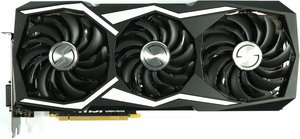
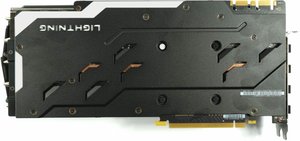
MSI employs a matte, graphite-colored plastic encompass that's quite angular in appearance. Yet it's still adequately conservative as far equally high-end graphics hardware goes. Those highlights can be changed out to taste; you also get a gold, red, and carbon-fiber-similar prepare to match other components in your PC.
The milky-white plastic inlay provides RGB lighting on the front and back, which y'all can command through a phone-based app or MSI'due south Gaming App software. If you accept other uniform components installed, their colors and furnishings tin exist synchronized. Nosotros don't mind the extra bit of flair, even if it does button the upper bounds of classy-looking.


The cooling fins are installed vertically, meaning heated air is pushed upward, out the pinnacle and down, toward your motherboard. Iii auxiliary eight-pin power connector line the bill of fare's top edge. They're rotated by 180° and then the connector release mechanisms aren't trapped up confronting heat sink.
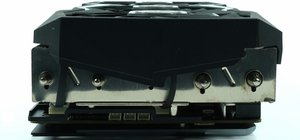
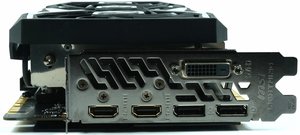
The complement of two DisplayPort 1.iv-ready connectors, one dual-link DVI-D output, and two HDMI two.0 ports reverberate a growing acceptance of VR HMDs (which use HDMI) and the gradual phasing out of DVI. Of those v interfaces, a maximum of four can be used simultaneously in a multi-monitor setup.

A GPU-Z screenshot provides the about pertinent technical information, fifty-fifty if the GPU Boost values we observed were much college than MSI'due south official specifications.
| NvidiaTitan X (Pascal) | NvidiaGeForce GTX 1080 Ti FE | MSIGTX 1080 Ti Lightning Z | NvidiaGeForce GTX 1080 FE | NvidiaGeForce GTX 980 Ti | |
|---|---|---|---|---|---|
| GPU | GP102 | GP102 | GP102 | GP104 | GM200 |
| CUDA Cores | 3584 | 3584 | 3584 | 2560 | 2816 |
| Base Frequency | 1417 MHz | 1480 MHz | 1582 MHz | 1607 MHz | one thousand MHz |
| Boost Frequency | 1531 MHz+ | 1582 MHz+ | 1695 MHz | 1733 MHz+ | 1076 MHz+ |
| Retentivity Size & Blazon | 12GB GDDR5X | 11GB GDDR5X | 11GB GDDR5X | 8GB GDDR5X | 6GB GDDR5 |
| Die Size | 471 mm² | 471 mm² | 471 mm² | 314 mm² | 601 mm² |
| Procedure Technology | 16nm | 16nm | 16nm | 16nm | 28nm |
| Transistors | 12 billion | 12 billion | 12 billion | 7.2 billion | viii billion |
| Streaming Multiprocessors (SM) | 28 | 28 | 28 | xx | 22 |
| GFLOPS (Base of operations Clock) | 10,157 | 10,609 | 11,340 | 8,228 | five,632 |
| Texture Units | 224 | 224 | 224 | 160 | 176 |
| Texture Fill Rate | 317.4 GT/southward | 331.5 GT/s | 354.4 GT/s | 257.one GT/due south | 214 GT/s |
| ROPs | 96 | 88 | 88 | 64 | 96 |
| Pixel Fill Charge per unit | 136 GPix/southward | 130.24 GPix/s | 139.two GPix/due south | 114.2 GPix/s | 116.vii GPix/s |
| Memory Information Rate | 10Gb/s | 11Gb/southward | 11Gb/s | 10Gb/s | 7Gb/s |
| Memory Bus | 384-fleck | 352-scrap | 352-bit | 256-bit | 384-bit |
| Memory Bandwidth | 480 GB/s | 484.4 GB/s | 489.3 GB/southward | 320 GB/south | 336 GB/s |
| L2 Cache | 3MB | 2816KB | 2816KB | 2MB | 3MB |
| TDP | 250W | 250W | 300W (PT) | 180W | 250W |
Examination Organization & Measurement Methods
We explained our test organisation and methodology in How We Exam Graphics Cards. If you want to larn more about the procedures nosotros're using in today's review, have a expect at that story. In the time since information technology was published, we also upgraded our CPU and cooling system to dominion out whatever possible host processing bottlenecks.
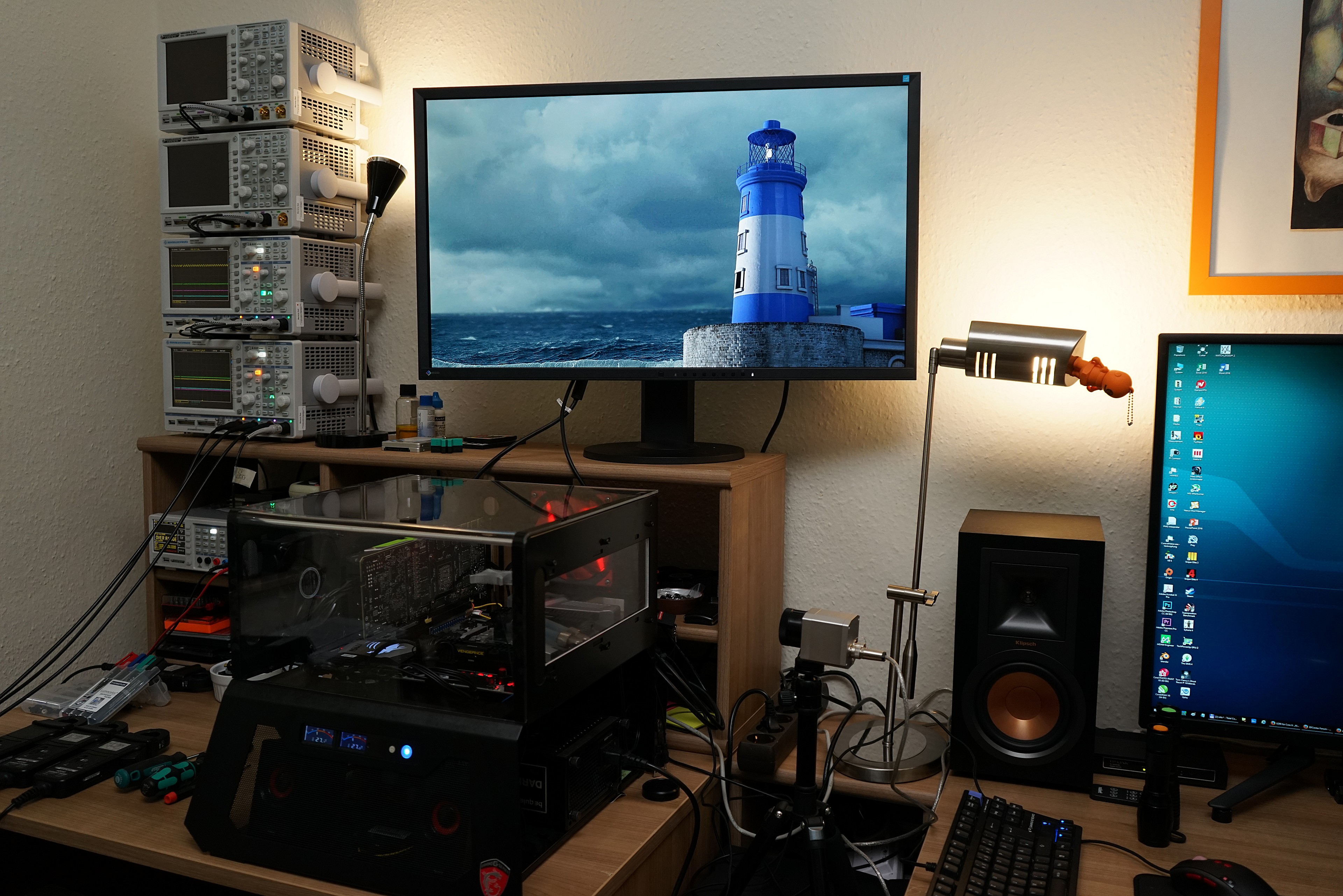
Here's a short summary in tabular array-form to provide a quick overview:
| Test Arrangement | |
|---|---|
| Organisation | Intel Cadre i7-6900K @ 4.iii GHzMSI X99S XPower Gaming TitaniumCorsair Vengeance DDR4-32001x 1TB Toshiba OCZ RD400 (Yard.ii, System SSD)2x 960GB Toshiba OCZ TR150 (Storage, Images)be placidity Dark Ability Pro 11, 850W PSUWindows ten Pro (All Updates) |
| Cooler | Alphacool Eisblock XPXAlphacool Eiszeit 2000 Chiller2x be quiet! Silent Wings 3 PWM (Closed Case Simulation)Thermal Grizzly Kryonaut (Used when Switching Coolers) |
| Instance | Lian Li PC-T70 with Extension Kit and ModsConfigurations: Open Benchtable, Closed Case |
| Monitor | Eizo EV3237-BK |
| Power Intake | Contact-free DC Measurement at PCIe Slot (Using a Riser Carte)Contact-free DC Measurement at External Auxiliary Power Supply CableDirect Voltage Measurement at Power Supply2x Rohde & Schwarz HMO 3054, 500MHz Digital Multi-Channel Oscilloscope with Storage Function4x Rohde & Schwarz HZO50 Current Probe (1mA - 30A, 100kHz, DC)4x Rohde & Schwarz HZ355 (10:one Probes, 500MHz)1x Rohde & Schwarz HMC 8012 Digital Multimeter with Storage Function |
| Thermography | 1x Optris PI640 80Hz Infrared Photographic camera + PI ConnectReal-Time Infrared Monitoring and Recording |
| Acoustics | NTI Audio M2211 (with Scale File, Low Cut at 50Hz)Steinberg UR12 (with Phantom Power for Microphones)Artistic X7, Smaart v.7Custom-Fabricated Proprietary Measurement Chamber, iii.5 x 1.8 10 ii.2m (L 10 D ten H)Perpendicular to Eye of Noise Source(s), Measurement Distance of 50cmNoise Level in dB(A) (Wearisome), Existent-time Frequency Analyzer (RTA)Graphical Frequency Spectrum of Noise |
More: Best Graphics Cards
More: Desktop GPU Performance Hierarchy Table
More: All Graphics Content
Source: https://www.tomshardware.com/reviews/msi-gtx-1080-ti-lightning-z,5162.html
0 Response to "Msi Geforce Gtx 1080 Ti Lightning Z Review"
Post a Comment